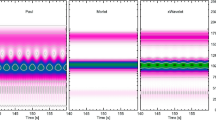Abstract
The quantification of stochastic substructures seen propagating away from the centers of emission lines of Wolf-Rayet (WR) stars is extended using the powerful, objective technique of wavelet analysis. Results for the substructures in one WR star so far show that the scaling laws between (a) flux and velocity dispersion and (b) lifetime and flux, combined with (c) their mass spectrum, strongly support the hypothesis that we are seeing the high mass tail-end distribution of full-scale supersonic compressible turbulence in the winds. This turbulence sets in beyond a critical radius from the star and shows remarkable similarity to the hierarchy of cloudlets seen in giant molecular clouds and other components of the ISM.
The velocity dispersion is larger on average for substructures (interpreted as density enhanced turbulent eddies) propagating towards or away from the observer, suggesting that the turbulence is anisotropic. This is not surprising, since the most likely force which drives the windand the ensuing turbulence alike, radiation pressure, is directed outwards in all directions from the star. It is likely that a similar kind of turbulence prevails in the winds of all hot stars, of which those of WR stars are the most extreme.
The consequences of clumping in winds are numerous. One of the most important is the necessary reduction in the estimate of the mass-loss rates compared to smooth outflow models.
Similar content being viewed by others
References
Daubechies, I. 1992,Ten Lectures on Wavelets, SIAM, Philadelphia
Falgarone, E., Phillips, T.G. & Walker, C.K. 1991,ApJ,378, 186
Farge, M. 1992,Ann.Rev.Fluid Mech.,24, 395
Fleck, R.C. 1992,ApJ,401, 146
Gill, A.G., Henriksen, R.N. 1990,ApJ,365, L27
Henrisksen, R.N. 1991,ApJ,377, 500
Langer, W.D., Wilson, R.W. & Anderson, C.H. 1993,ApJ,408, L45
Larson, R.B. 1981,MNRAS,194, 809
Moffat, A.F.J., Drissen, L., Lamontagne, R. & Robert, C. 1988,ApJ,334, 1038
Moffat, A.F.J. & Robert, C. 1992,ASPC,22, 203
Moffat, A.F.J. & Robert, C. 1993,ApJ, submitted
Moffat, A.F.J. 1993,in preparation
Owocki, S.P., Castor, J.I. & Rybicki, G.B. 1988,ApJ,335, 914
Robert, C. 1992,Ph.D. thesis, Univ. de Montréal
St-Louis, N. 1990,Ph.D. thesis, Univ. College London
Williams, J.P. & Blitz, L. 1993,ApJ,405, L75
Wolfire, M.G., Hollenbach, D. & Trelens, A.G.G.M. 1992,ApJ,402, 195
Author information
Authors and Affiliations
Rights and permissions
About this article
Cite this article
Moffat, A.F.J., Lépine, S., Henriksen, R.N. et al. First wavelet analysis of emission line variations in Wolf-Rayet stars. Astrophys Space Sci 216, 55–65 (1994). https://doi.org/10.1007/BF00982468
Issue Date:
DOI: https://doi.org/10.1007/BF00982468



